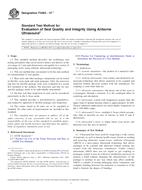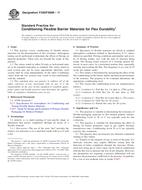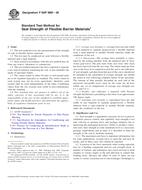We need your consent to use the individual data so that you can see information about your interests, among other things. Click "OK" to give your consent.
ASTM D3715/D3715M-98(2011)
Standard Practice for Quality Assurance of Pressure-Sensitive Tapes
STANDARD published on 1.4.2011
The information about the standard:
Designation standards: ASTM D3715/D3715M-98(2011)
Note: WITHDRAWN
Publication date standards: 1.4.2011
SKU: NS-24591
The number of pages: 6
Approximate weight : 18 g (0.04 lbs)
Country: American technical standard
Category: Technical standards ASTM
The category - similar standards:
Annotation of standard text ASTM D3715/D3715M-98(2011) :
Keywords:
pressure-sensitive tape, quality assurance, sampling, Acceptance criteria/testing, Conformance/conformity assessment, Defects, End-item examination, Pressure-sensitive tapes, Quality assurance (QA), Sampling, Surface analysis--pressure-sensitive tapes, ICS Number Code 83.180 (Adhesives)
Additional information
| Significance and Use | ||
|
The quality of a tape product is determined by the quality systems of the tape producer, including all processes involved in the engineering and production of the product. It is recommended that appropriate sections of ANSI/ASQC Q94 be included in a producer's quality systems. This practice does not intend to standardize these systems. A producer's reputation, a producer's certification of conformance, or evidence of a producer's quality systems are often sufficient to ensure a purchaser or user of a consistent quality. Acceptance sampling is useful when an objective basis of contract or specification conformance is desired. The intention of this practice is to provide a reasonably simple document which can be used by both the buyer and seller of pressure-sensitive tape to determine if the product offered for sale meets some predetermined specification for the product. This practice offers the procedures for determining the size of the sample to be inspected and the criteria for determining whether the lot (amount of material offered for sale) should be accepted or rejected. This practice draws from and is based on both ANSI/ASQC Z1.4 and ANSI/ASQC Z1.9. Two forms of sampling plans are included: sampling by attributes and sampling by variables. Sampling by attributes is used for end-item examination and both are used where appropriate for end-item testing. Sampling by attributes has the advantage of simplicity while sampling by variables has the advantage of costing less for the equivalent assurance of the correctness of decisions. Sampling plans for inspection by attributes (see Table 2), should be used for end-item examination (see 5.3). Sampling plans for inspection by variables (see Table 1 and 5.4), should be used for end-item testing except as indicated in 5.4.1.2(a). Use of this practice assumes that a specification defining one or more quality characteristics exists. It is suggested that buyer and seller agree on acceptable quality levels (AQL) from within the choices shown in the tables of this practice. When conditions warrant switching from normal to tightened or reduced inspection, the appropriate sampling plans are available in Table 1 and Table 2. The decision to switch should be agreed upon between the buyer and the seller. When lots are rejected under normal inspection it is usual to go to tightened inspection. No change in AQL is made, but the assurance of making the correct decision is improved usually by the sampling plan calling for a larger sample size. Reduced inspection is a switch from normal inspection made when some number of lots, usually 10, passes in consecutive order. Switching should move from reduced to normal and from normal to tightened or from tightened to normal without skipping an intermediate step. |
||
| 1. Scope | ||
|
1.1 This practice contains uniform quality assurance provisions for pressure-sensitive tapes and establishes sampling plans and procedures for acceptance inspection. 1.2 Limitations: 1.2.1 This practice only includes procedures for when an upper or a lower specification limit is given. It does not provide for double, both minimum and maximum, specification limits. Note 1—When double specification limits are given (applies to variables testing only), use may be made of Table C-3 and Example C-3 of ANSI/ASQC Z1.9. 1.2.2 The variables sampling plans apply to a single quality characteristic. Having obtained the sample and the responses to the physical property tests, acceptance is determined on one quality characteristic at a time. The process is repeated for each additional characteristic. 1.2.3 The variables sampling plans require that the response to each quality characteristic is normally distributed either directly or by transformation. If this is not known, the potential user of this practice should seek the counsel of someone with sufficient understanding of statistical techniques to provide that information. 1.3 The values stated in either SI or inch-pound units are to be regarded separately as standard. The values stated in each system may not be exact equivalents; therefore, each system must be used independently, without combining values in any way. 1.4 This standard does not purport to address all of the safety concerns, if any, associated with its use. It is the responsibility of the user of this standard to establish appropriate safety and health practices and determine the applicability of regulatory limitations prior to use. |
||
| 2. Referenced Documents | ||
|
Similar standards:
Historical
1.12.2010
Historical
1.8.2013
Historical
15.11.2013
Historical
1.4.2013
Historical
1.4.2011
Historical
15.6.2009
We recommend:
Technical standards updating
Do you want to make sure you use only the valid technical standards?
We can offer you a solution which will provide you a monthly overview concerning the updating of standards which you use.
Would you like to know more? Look at this page.



 ASTM F2825-10e1
ASTM F2825-10e1 ASTM F3004-13e1
ASTM F3004-13e1 ASTM F3039-13
ASTM F3039-13 ASTM F34-13
ASTM F34-13 ASTM F392/F392M-11..
ASTM F392/F392M-11.. ASTM F88/F88M-09..
ASTM F88/F88M-09..
 Cookies
Cookies
